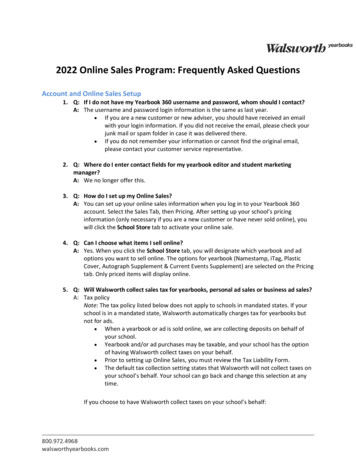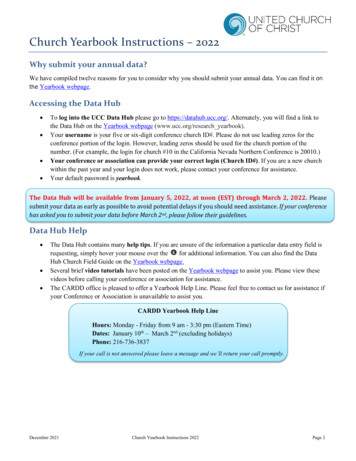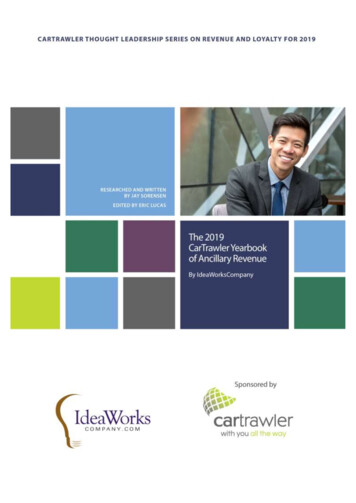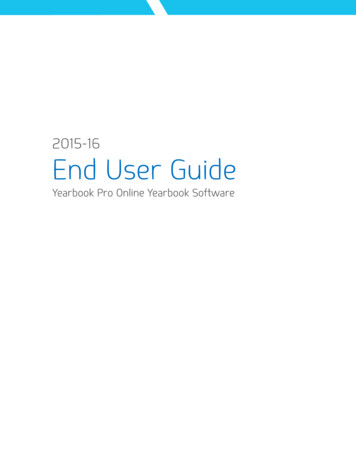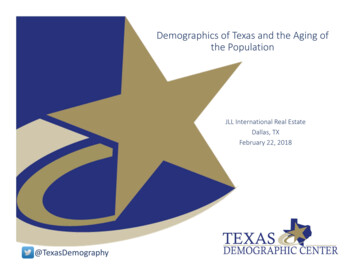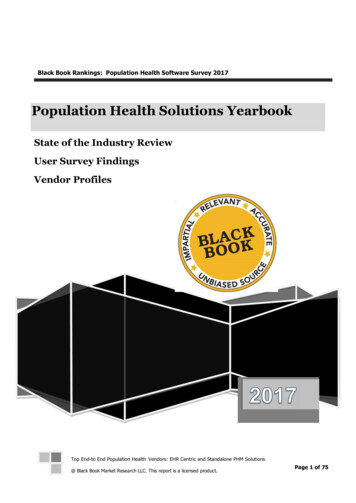
Transcription
Black Book Rankings: Population Health Software Survey 2017Population Health Solutions YearbookState of the Industry ReviewUser Survey FindingsVendor ProfilesTop End-to End Population Health Vendors: EHR Centric and Standalone PHM Solutions@ Black Book Market Research LLC. This report is a licensed product.Page 1 of 75
Black Book Rankings: Population Health Software Survey 2017Black Book annually evaluates leading population health solutions software and service providers across 18 operationalexcellence key performance indicators completely from the perspective of the client experience. Independent andunbiased from vendor influence, more than 580,000 healthcare IT users are invited to contribute to various annualcustomer satisfaction polls. Suppliers also encourage their clients to participate to produce current and objective customerservice data for buyers, analysts, investors, consultants, competitive suppliers and the media. For more information orto order customized research results, please contact the Resource Center at 1 800.863.7590 or info@BrownWilson.com 2016-2017 Black Book Market Research LLC All Rights Reserved.FIERCELY INDEPENDENTBlack Book , its founders, management and staff do not own or hold any financial interest in any of thevendors covered and encompassed in the surveys it conducts. Black Book reports the results of thecollected satisfaction and client experience rankings in publication and to media prior to vendornotification of rating results and does not solicit vendor participation fees, review fees, inclusion orbriefing charges, and/or vendor.Reproduction of this publication in any form without prior written permission is forbidden. The information containedherein has been obtained from sources believed to be reliable. Brown-Wilson Group, Inc. the parent corporation of BlackBook , Black Book Rankings LLC, Black Book Market Research LLC, and The Black Book of Outsourcing , disclaims allwarranties as to the accuracy, completeness or adequacy of such information. Brown-Wilson Group shall have no liabilityfor errors, omissions or inadequacies in the information contained herein or for interpretations thereof. The reader assumessole responsibility for the selection of these materials to achieve the intended results. The opinions expressed herein aresubject to change without notice. Brown-Wilson Group's unrivaled objectivity and credibility is perhaps your greatestassurance. At a time when alliances between major consultancies and suppliers have clouded the landscape, Brown-WilsonGroup remains resolutely independent. We have no incentive to recommend specific EHR PM/RCM software vendors. Ouronly allegiance is to help you achieve the results you want with the best possible solution.For more information, visit www.BlackBookMarketResearch.com2017 Population Health Yearbook@ Black Book Market Research LLC. This report is a licensed product.Page 2 of 75
Black Book Rankings: Population Health Software Survey 2017TABLE OF hcareSURVEYPlatforms&AGGREGATED RESPONSE FINDINGS:Market Changes and Vendor Consolidations forming End -to-EndSolutionsMarket DefinitionsTrending in 2017BLACKBOOK METHODOLOGYHow the data sets are collectedUnderstanding the statistical confidence of Black Book dataWho participates in the Black Book Ranking processMarketplace DefinitionsCOMPETITIVE PROFILES & ANALYSISTABLE OF TABLESTable 1: Top Vendors offer Population Health Software as major or onlyrevenue 2016-2017Table 2: Top Vendors offer Population Health Software as minorrevenue 2016-2017Table 3: Vendor list on basis of Individual Key Performance Indicator2017 Population Health Yearbook@ Black Book Market Research LLC. This report is a licensed product.Page 3 of 75
Black Book Rankings: Population Health Software Survey 2017Competitive Profiles Technical Analysis ofalphabetical order as submitted by vendors)Table 4: Allscripts HealthCare SolutionsTable 5: athenahealthTable 6: CaradigmTable 7: CernerTable 8: DeloitteTable 9: Enli (Kryptiq)Table 10: Epic SystemsTable 11: Evolent HealthTable 12: Explorys IBMTable 13: Forward HealthTable 14: GeneiaTable 15: GreenwayTable 16: Healthagen MedicityTable 17: Health CatalystTable 18: Humana Transcend InsightsTable 19: i2iTable 20: IBM Watson HealthTable 21: Influence Health (MedSeek)Table 22: LumerisTable 23: McKessonTable 24: MedeanalyticsTable 25: NextGenTable 26: OptumRepresentativeVendor(in2017 Population Health Yearbook@ Black Book Market Research LLC. This report is a licensed product.Page 4 of 75
Black Book Rankings: Population Health Software Survey 2017Table 27: Phytel IBMTable 28: Practice FusionTable 29: PremierTable 30: Rise Health – Best DoctorsTable 31: Sandlot SolutionsTable 32: Streamline HealthTable 33: The Advisory Board Company - CrimsonTable 34: Truven Health IBMTable 35: ValenceTable 36: Wellcentive PhilipsTable 37: ZeOmega2017 Population Health Yearbook@ Black Book Market Research LLC. This report is a licensed product.Page 5 of 75
Black Book Rankings: Population Health Software Survey 2017UTIVE SUMMARYTHE STATE OF POPULATION HEALTHQ1 2017Although relatively new in the United States, the concept of population health management (PHM) has been progressingfor some time in many other countries with public healthcare programs, including France, Germany, Switzerland, theUnited Kingdom and Canada. Population health’s recent introduction in the U.S. is due to several factors, not the least ofwhich is the fact that the old fee-for-service healthcare model was not producing desired results. According to a 2015Commonwealth Fund study, the U.S. spends far more on healthcare than any other high-income nation, yet has a lowerlife expectancy and worse health outcomes.So as healthcare in the United States continues its transition from a quantity-based to a quality-based system, it makessense to learn from other countries who have more successfully melded population health into their respective systems,thereby improving population health, reducing per-capita cost and improving the quality of the patient experience -- thethree tenets of the Triple Aim, developed by the Institute for Healthcare Improvement (IHI) for optimizing health systemperformance.As vendors begin competing for a piece of the still-baking population health pie, we’re seeing evidence of a change inoverall consciousness regarding the topic. In 2016, the National Health Institute launched a program to study socialhealth disparities between people of different ethnic groups, socioeconomic status and locations. Meanwhile, the Centersfor Disease Control is ramping up its Division of Population Health. And in 2017, HIMSS will unveil its newly createdPopulation Care Management Knowledge Center to educate conference visitors on methods to implement a successfulcare coordination and management program. Also featured at HIMSS17 will be dozens of educational sessions focusingon population health tactics and techniques.Importance of engagement, interoperable data and data captureAccording to the Robert Wood Johnson Foundation, 80 percent of what influences health outcomes are factors outsidethe purview of traditional healthcare delivery. These include behaviors, social and economic factors, location and qualityof environment. This is why patient engagement is such an important aspect of managing population health.As PHM continues to expand, the number of solutions to increase patient engagement will grow. One of the mostvaluable methods for encouraging patient engagement is providing web-based access to healthcare information throughonline patient portals.Having interoperable data across the entire continuum of care is imperative for providers to manage population health.For years, health professionals have been clamoring for public policies that require health IT interoperability standards sothat providers can access data from any system.Part of the problem is that many solutions of the not-too-distant past, including EMRs, RCM software and claimsprocessing systems, were coded with a fee-for-service platform in mind. End-to-end PHM solutions need to be able toidentify each cost at the point of care (POC) and throughout the entire continuum of care, as well as aftercare.2017 Population Health Yearbook@ Black Book Market Research LLC. This report is a licensed product.Page 6 of 75
Black Book Rankings: Population Health Software Survey 2017POC solutions vendors will continue to ramp up production, especially wearables that can collect continuous patient data.Clinical data has previously been mostly limited to EHRs, which is why it’s no surprise that six of the top 20 PHM vendorsare EHRs with two-thirds of the installs represented in this survey. Historically, EHR clinical data consisted mostly ofhealth “snapshots” during doctor and/or hospital visits. As PHM solutions continue to grow, there will be a concurrentexpansion in all the different ways of gathering clinical data at the POC and in near-real time.In order to maximize the value and benefits of a PHM solution, it is imperative that we master the art of data capture.Collecting continuous data on whole populations, from the sick to the healthy, will help fuel the immense data appetitefor next-generation PHM solutions.Also on the rise are solutions that: utilize both claims and clinical data to identify at-risk patients, help locate missing orinconsistent clinical documentation, and enhance collaboration between providers, patients and payers. As paymentmodels continue to shift toward value and payers and providers assume greater risk, they will need tools to help improvecollaboration and communication as they work to meet the Triple Aim (improve patient satisfaction and care qualitywhile reducing unnecessary cost).Coders as data gatherersAs we continue our shift from quantity-based to quality-based healthcare, coding will no longer be used solely forhelping to ensure that organizations are properly reimbursed. In fact, coders will be elevated to the position of primarydata gatherers for population health analytics.Nowhere is this more evident than when coding for the top 10 killers as listed by the CDC. As coded data and its analysisgets more refined, causes of these killers, as well as ways to reduce their prevalence, will be revealed.And, with regard to the expansion of external cause codes, this means that the more information that can be coded, thebetter; information pertaining to not only disease diagnoses, but also causes (What happened? Where did it happen?)will improve population health.Black Book Population Health Surveys, Polls and Competitive Market AnalysisWith much vendor merger & acquisition (M&A), there are vendors who are now offering full end-to-end PHM platformsand solutions. Of the top 20 population health vendors, six are EHRs with about 2/3 of the installs.EHR clients are turning to their EHR vendors for PHM value adds and bolt-on PHM value-based care (VBC) solutions first.Allscripts, Cerner, Epic, athenahealth and NextGen have clients reporting comprehensive programs running currently2017 Population Health Yearbook@ Black Book Market Research LLC. This report is a licensed product.Page 7 of 75
Black Book Rankings: Population Health Software Survey 2017within those vendors. Issues with Epic continue, as with other garden-walled health exchanges. The same lack ofinteroperability exists with Care Coordination and Referral Networking; if you’re not an Epic client and you’re not goingto switch to Epic, for example, you’re not going to get in-network referrals. Hence, the higher satisfaction with Allscriptsand Cerner who are actually vendor agnostic to other EHRs in the PHM process. EHR vendors are aggressively looking topenetrate the best-of-breed PHM market with Allscripts, athenahealth, NextGen, Meditech and Cerner all enhancing their2017 analytics offerings (a function of PHM that the best of breed had a strong hold on thus far).It seems very few integrated delivery networks (IDNs) and accountable care organizations (ACOs) really know wherethey are at with IT collectively. Vendors pushed so many products on healthcare organizations, it sometimes became ahodge podge of analytics, engagement, and enterprise data warehouses (EDWs), care coordination and diseasemanagement pieces with little to no integration. That’s why we are forecasting (from surveys) a huge leap in the use ofPHM VBC consultants in 2017, mostly to help with assessments, strategies and vendor selection.To a large extent, its like buyers were sold a variety of trains long before tracks were put down. At this point, buyers aregoing back and figuring out how to lay track as cheaply as possible.Regarding vendor selection, the decision on PHM and VBC vendors is becoming more of a business decision than an ITdecision as tech funding and budgets are drained, according to Black Book’s Q4 2016 C-suite poll on purchasing trends.More organizations are looking more for the ability to get along adequately at the least total cost of ownership through2017 than are those concerned with maximizing return on investment (ROI) on a high-dollar PHM system.Of the 235 hospitals that reported having full end-to-end population health capabilities currently under the roof in 2016,only 54% state seeing a measurable result. 70% of those are EHR vendor PHM users. The dream of the one-stop shopthat meets everyone’s needs is a reality for some and evolving quickly for others.Non-EHR vendors are making the play to replace some EHR products as needs become more value based and reformsmake individual hospital needs more specific. Black Book separated EHR PHM solutions from best of breed because mostbest of breed do one or two functions of the PHM spectrum well, and the other four or five with less satisfaction.However, among the top 5 EHRs PHM solutions, we saw consistent satisfaction across all PHM functions (except Epic onCare Coordination and Referral Networks). Since the purchasing trend is to go to EHRs first for end-to-end PHM, BlackBook showed their performances separately.There have been many recent mergers and acquisitions (M&A) in the healthcare IT space this past year aimed atachieving end-to-end PHM and value-based care (VBC) solution offerings. We’re also seeing consultants utilizing theM&A strategy to beef up their EHR, interoperability and data analytics bases, as well as the merging of some consultingfirms and PHM companies, and company rebranding to maximize focus on PHM solutions.Optum with Humedica - Part of insurance behemoth UnitedHealth Group, Optum acquired Humedica, a Boston-basedclinical analytics firm, back in 2013, with the goal of gaining access to clinical data through EHRs.2017 Population Health Yearbook@ Black Book Market Research LLC. This report is a licensed product.Page 8 of 75
Black Book Rankings: Population Health Software Survey 2017IBM with Truven - IBM purchased Truven Health Analytics in early 2016 for 2.6 billion. It was IBM’s fourth health-datarelated acquisition in a year (others were Explorys, Phytel and Merge).Advisory Board with Clinovations and Crimson - In 2015, the Advisory Board purchased Crimson, an EHR optimizationfirm, and Clinovations, a consulting service that helps maximize IT value.Philips with Wellcentive - In 2016, in order to boost its PHM business, Royal Philips purchased Wellcentive, a provider ofPHM software solutions.McKesson with Change Healthcare - Last year, McKesson combined most of its IT business with Change HealthcareHoldings Inc., a provider of software and analytics, network solutions and technology-enabled services. The newcompany has a combined pro forma annual revenue of 3.4 billion.Evolent with Valence - Also last year, Evolent Health purchased most of Valence Health for 145 million in cash andstock, merging two large, competing consulting firms that work with hospitals, doctors and insurers on value-basedpayment designs.Best Doctors with Rise Health - In 2014, Boston-based Best Doctors, which contracts with large employers to provideexpert physician opinions to employees, acquired Chicago’s Rise Health, a company focused on PHM.Cognizant with TriZetto - In 2014, Cognizant purchased TriZetto for 2.7 billion in order to beef up its healthcarebusiness.Allscripts with DB Motion - In 2013, Allscripts acquired Israel-based dbMotion, which normalizes data from differentEHRs, for 235 million.NTT Data with Dell - In 2016, Japan’s NTT Data acquired Dell Services, Dell’s IT consulting division, for 3.1 billion.Atos with Anthelio - Also last year, IT concern Atos purchased healthcare IT outsourcing company Anthelio HealthcareSolutions for 275 million.Enli (formerly Kryptiq) - In 2015, Kryptiq changed its name to Enli Health Intelligence to reflect its focus on PHM.StartupHealth reported a record 7.9B invested in digital health in sum in 2016, with the majority going to PopulationHealth and Patient Experience. Here’s how it breaks down: Consumer Experience 2.8B in 163 deals; Personalized Health 765M in 45 deals; Big Data and Analytics 562M in 54 deals;2017 Population Health Yearbook@ Black Book Market Research LLC. This report is a licensed product.Page 9 of 75
Black Book Rankings: Population Health Software Survey 2017 Population Health 436M in 52 deals; and Clinical Decision Support 322M in 22 deals.Key findingsOrganizations on the transition path to PHM must prioritize three foundational elements, according to surveyrespondents:1.Information-powered clinical decision making (98%);2.Primary care-led clinical workforce (96%); and3.Patient engagement and community integration (93%).PHM solutions are quickly becoming a priority for healthcare providers, including physician organizations, accountablecare organizations, integrated delivery networks, hospitals and health systems, but in Q1 2017, 81% of providers aretackling population health projects without a strategic technology purchase that meets all their needs. Nearly a third ofthose providers are using free or value-added tools from their EHR vendor as a stop-gap solution.In Q1 2015, 83% of healthcare executives are increasingly looking beyond vendors who supply their core financial(patient accounting) and clinical information systems (EHRs) at more specialized vendors. In Q1 2017, three EHRcompanies have overwhelmingly reversed the earlier stance of those providers seeking external best-of-breed PHMvendors. The surveyed clients of Allscripts (84%), Cerner (81%) and Epic Systems (77%) indicated they are or areplanning to adopt the comprehensive population health solutions of their core EHR and/or financial systems by 2018.83% of hospitals and 86% of physicians responding to the survey state their community health information exchanges(HIEs) are still too insufficient or simply not operating at the point where they solve the reliable data needs of populationhealth modeling.90% of all surveyed decision makers on hiring a consultancy agree that they prefer an advisor with both PopulationHealth Management and Revenue Cycle Management expertise.2017 Population Health Yearbook@ Black Book Market Research LLC. This report is a licensed product.Page 10 of 75
Black Book Rankings: Population Health Software Survey 2017Current and prospective RCM consultant clients estimate over 400% growth in PHM consulting engagements through2018, as measured against 2016 actual dollar spend/utilization of advisors.Of the 58 PHM head-hunting firms contacted by Black Book, about one-third claim they are currently experiencingdifficulties finding qualified PHM process experts to fill open positions, and 90% anticipate longer searches ahead fornext generation-qualified PHM staff as the industry confronts PHM expert shortages in 2017.Hospital executives primarily attribute the increased demand for PHM advisory services on several factors out of theirscope of current experience: 77% have no strategic plan activated for transforming PHM or value-based care solutions end-to-end toconfront known deadlines because there are no internal experts identified; Of the 84% stating they are either acquiring, replacing either (or all) PHM IT solutions, vendors, current servicedelivery processes or outsourcers within the next 12-18 months, less than 20% of hospitals have begun comprehensivevendor selection activities and are considering consultants to assist them; 89% of CFOs confirm they are confident that the hospital does have the FTEs budgeted for PHM transformationactivities; and 80% of CIOs state they do not have the information technology or staff in-house needed to transform PHMend-to-end as their executive team envisions.Real end-to-end PHM transformations require complex technology optimization, strategic assessment of patient mix andpayers, analytics, decision support tools, staff training, outsourcing and new software implementations. Next generationPHM will not be achieved via old school directives to cut staff, slash expenses, and pushing PHM work with the lowestcost tech vendor. The new era of how providers get paid is going to impact the entire organization, and most hospitalsaren’t remotely prepared for it.INTRODUCTIONEND-TO-END POPULATION HEALTH TOOLS2017 Population Health Yearbook@ Black Book Market Research LLC. This report is a licensed product.Page 11 of 75
Black Book Rankings: Population Health Software Survey 2017Black Book received 1,740 completed surveys on Best of Breed PHM end to end solutions vendors corresponding to aresponse rate of 21.2% of individuals and 30% of institutions invited to the population health solutions and servicessurveys between Q2 2016 and Q1 2017. Additionally, 3,040 surveys from executives in purchasing decision moderesponded to questions on vendor preferences, budgets and adoption in pre-use, implementation, system decisionmaking or purchased but not yet installed status (these ballots did not evaluate vendor performance).711 EHR clients evaluated Core EHR PHM end to end solutions.1,116 providers that have engaged PHM and VBC consultants and advisors in 2016 also completed ballots on a separateBlack Book client satisfaction survey.Black Book Market Research’s Population Health Software client/user/prospective customer surveyinvestigated 69 PHM self-stated full spectrum solutions vendors from which 3 5 responded directly viaclient reviews.Inherent to making the transition to population health management is the ability to assume financial risk. This newlycharted territory for most health care providers has left nearly 3 in 4 hospitals with incomplete planning, strategies,technologies, and services stymied on the path to ensure a successful transition to value based care.With only 37 PHM vendors reporting they actively support a full end-to-end solution set, it is critical the buyers articulatetheir population health business goals before they select a vendor, whether their core EHR or financial system vendorpartner, or a best of breed standalone PHM vendor.Organizations on the transition path to population health management must prioritize three foundational elementsaccording to survey respondents:Information-powered clinical decision making (98%)Primary care led clinical workforce (96%)Patient Engagement and Community Integration (93%)Population health solutions are quickly becoming a priority for healthcare providers including physician organizations,accountable care organizations, integrated delivery networks, hospitals and health systems, but in Q1 2017:1.) 81% of providers are tackling population health projects without a strategic technology purchase that meets alltheir needs.Nearly a third of those providers were using free or value-add tools from their EHR vendor as a stop gapsolution.2.) 19% of surveyed providers utilize a vendor-provided solution to address their current population healthprojects.2017 Population Health Yearbook@ Black Book Market Research LLC. This report is a licensed product.Page 12 of 75
Black Book Rankings: Population Health Software Survey 2017What Makes Up an End-to-End Population Health Solution? (Percent that have a solutionmodule in place)Administrative and Financial Performance Monitoring 77%Analytics27%Care Coordination and ImprovementCoding91%97%Data Aggregation49%Patient Engagement59%Physician and Clinician EngagementQuality MeasurementRisk Stratification29%92%31%Utilization of network resources50%Of those 11%, roughly half chose a single vendor in an attempt to capture all their population health initiativesinto a focused unified data model. The remaining providers have a collection of solutions from 2 or morevendors.3.) In Q1 2015, 83% of healthcare executives are increasingly looking beyond vendors who supply their corefinancial (patient accounting) and clinical information systems (EHRs) at more specialized vendors.In Q1 2017, three EHR companies have overwhelmingly reversed the earlier stance of those providers seekingexternal best-of-breed PHM vendors. The surveyed clients of Allscripts (84%), Cerner (81%) and Epic Systems(77%) indicated they are or are planning to adopt the comprehensive population health solutions of their coreEHR and/or financial systems by 2018.2017 Population Health Yearbook@ Black Book Market Research LLC. This report is a licensed product.Page 13 of 75
Black Book Rankings: Population Health Software Survey 2017EHR CLIENTS PLANNING TO IMPLEMENT1 PHM VBC SOLUTIONS THROUGHTHEIR CORE EHR VENDOR BY Q3 2018Practice nGE HealthcareathenahealthNextGenCPSIEpic SystemsCernerAllscripts01020304050607080904.) 83% of hospitals and 86% of physicians responding to the survey state their community health informationexchanges (HIEs) are still too insufficient or simply not operating at the point where they solve the reliable dataneeds of population health modeling.2017 Population Health Yearbook@ Black Book Market Research LLC. This report is a licensed product.Page 14 of 75
Black Book Rankings: Population Health Software Survey 20175.) 42% of respondents rate population health as “vitally essential” to the 2018-2019 success of their organization,down from 51% in Q1 2016. 86% report population health as “somewhat to moderately impactful”, down from95% in Q1 2016.6.) 84% of respondents state there are still in the business model trialing of population health and not in any formof upside gain/downside risk agreements with payers. 78% of provider CFO respondents have beenunsuccessful at finding payers who are willing to enter into agreements on population health initiatives.Current Organizational Status forPopulation Health Initiatives in Q1 201738%46%Planning with External Partners(Payers or Employers)Currently in 2 Agreements16%Planning internally withoutPartners2017 Population Health Yearbook@ Black Book Market Research LLC. This report is a licensed product.Page 15 of 75
Black Book Rankings: Population Health Software Survey 20177.) 70% of respondents have not instituted a formal leadership structure of population health management in theirorganizations. Currently, population health and accountable care strategic programs fall under theresponsibility of multiple managers.Who is Leading Your PHM Initiative Currently?Chief Medical Officer 19%Chief Executive Officer 18%Chef Quality Officer 9%Chief Operating Officer 8%Chief Nursing Officer 8%Population Health Executive 5%Other Titles 33%8.) By 2018, a 42% of all provider organizations anticipate new financial risk structures in caring for an identifiedpopulation. Still, 22% of provider organization expect no involvement in different financial risk structures by2018.Shared Profit and Loss Arrangements with Payers42%Direct Contracting with Employers 21%Joint Ventures with Health Insurance 18%Shared Savings Programs with Payers 15%Start up a payer organization within the network 8%None 22%9.) What risk sharing arrangements is your organization engaged in to improve the health of a defined population?Patient centered medical home related arrangements 53%Clinically Integrated Networks 62%Health system led (physician and hospital) Accountable Care Organizations 40%Expansion of ACO to nonhospital providers 39%Acquisition of providers 52%2017 Population Health Yearbook@ Black Book Market Research LLC. This report is a licensed product.Page 16 of 75
Black Book Rankings: Population Health Software Survey 2017Alliances with providers 30%None 12%10.) Primary Factor for Pursuing Population Health Management Solutions and Tools: Reimbursement WorriesAnticipation of end of fee-for-service model45%Better control of clinical quality, costs and outcomes27%Organizational Mission11%Competitive Advantage 10%Current or Anticipated Governmental Penalties3%Other4%2017 Population Health Yearbook@ Black Book Market Research LLC. This report is a licensed product.Page 17 of 75
Black Book Rankings: Population Health Software Survey 2017BLACK BOOK POPULATION HEALTH SOFTWARE USERS SURVEY RESULTSSTATE OF THE POPULATION HEALTH MANAGEMENT SOFTWARE IN HEALTH CARE INDUSTRYThe healthcare industry is undergoing a fundamental transformation globally as it shifts from a volume based business to a value -based business. Growing demands from consumers, for improved healthcarequality and greater value, are forcing healthcare providers and payers to deliver optimized outcomes.In addition, governments across the globe are increasingly wor king towards reducing healthcare costs,which increases the burden on payers and providers to meet government as well as consumerexpectations. Thereby compelling them to move towards population health management solutions, whichenable them to provide imp roved healthcare at reduced costs.Population health management is a methodical and transparent delivery of services to improve the healthstatus of a give population at a prospective price and to deliver
Of the top 20 population health vendors, six are EHRs with about 2/3 of the installs. EHR clients are turning to their EHR vendors for PHM value adds and bolt-on PHM value-based care (VBC .




